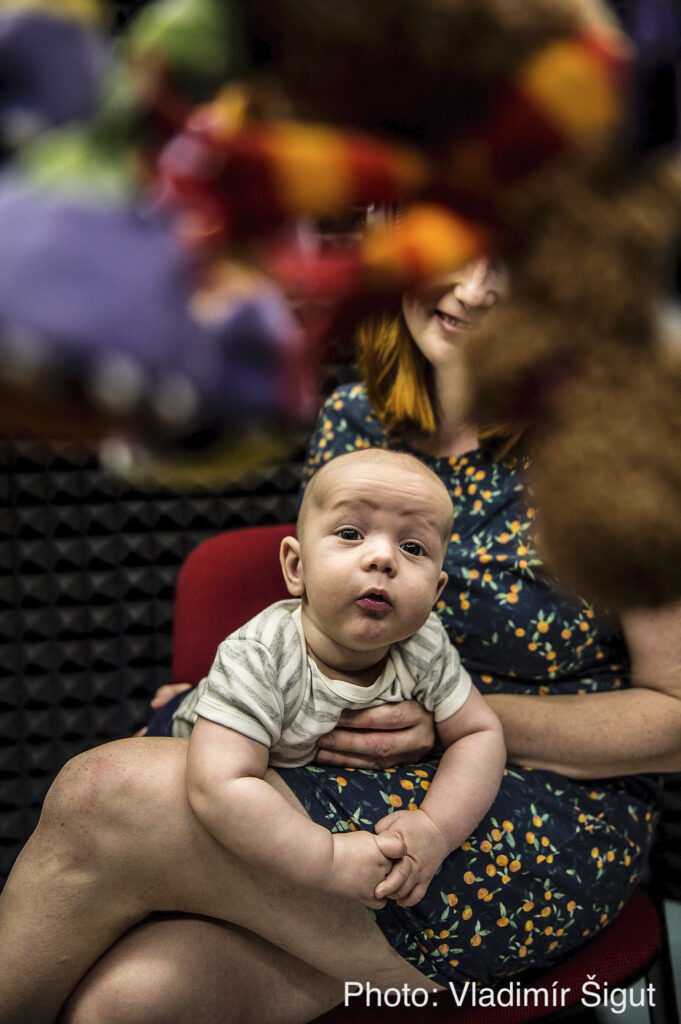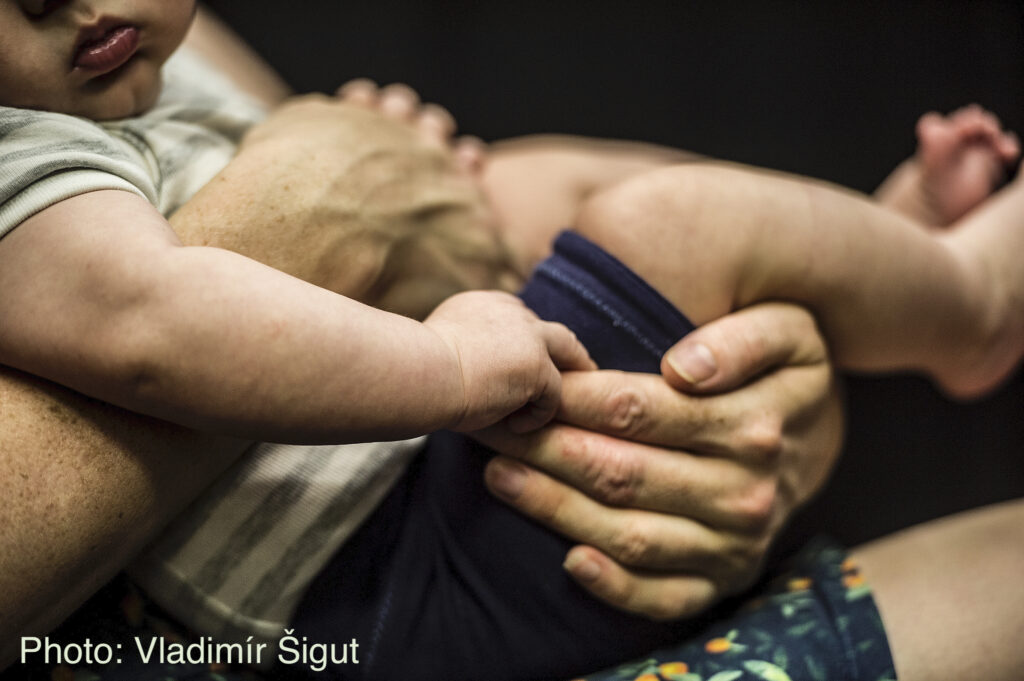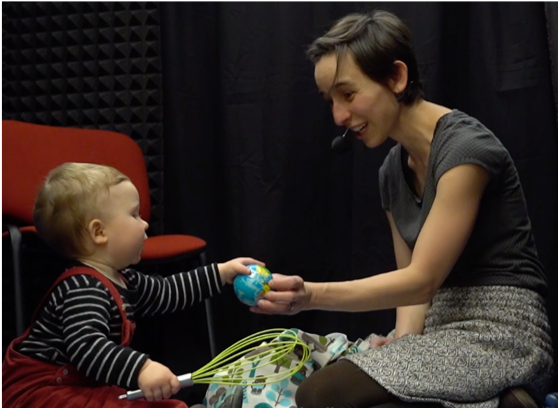Speech learning in infancy
Speech learning before birth
It is now well known that babies learn about their native language well before they are even born. Scientists generally agree that it is language melody and rhythm what is learnt prenatally. We reasoned that it is physiologically and acoustically equally possible that unborn babies may learn about the individual speech sounds (i.e. phonemes) of their native language and went on to test that prediction.

In this project, we examine whether at birth, babies show signs of prenatal learning of native-language vowels (namely, the Czech a, e, and é) We have tested over a hundred newborns with electroencephalography (EEG), and recorded how sleeping, one to two days old babies process vowels and comparable nonspeech sounds.
We have found that the babies processed the vowel, speech stimuli more robustly than they processed the nonspeech stimuli. Moreover, for the vowels, their brains showed higher level (perhaps abstract) processing asymmetries which very much resemble those previously found in adults. Our findings are explainable in terms of prenatal category formation. However, alternative explanations in terms of speech-specific acoustic confounds in our stimulus material, or even some degree of innateness for speech processing, cannot be ruled out. We thus continue to investigate prenatal speech learning through computational simulations (project below) and, hopefully, future cross-linguistic comparisons.
Our manuscript reporting this newborn project is currently under review. You can have a look at a poster with interim analyses that we presented at the Boston University Conference on Language Development.
This project is done in close collaboration with Jan Kremláček (Faculty of Medicine in Hradec Králové). We’re grateful to Gábor Stefanics (University of Zurich) who shared his expertise on newborn EEG testing.
Understanding speech in newborns

Previous research has shown that there is a strong link between what a baby hears before birth, especially during the third trimester, and how it processes speech after birth. Thus far, we know that babies respond more strongly to their mother tongue than to an unfamiliar language, to a nursery rhyme they have heard versus an unfamiliar one, and they also cry in a melodic contour of their mother’s language. However, all previous studies have worked with babies who were already prenatally exposed to language input. Our goal is therefore to compare speech processing in newborns whose mothers are native speakers of Czech, native speakers of Russian, and also whose mothers use Czech Sign Language for their primary communication. We want to find out if the readiness for human speech in newborns is rather modified by prenatal exposure to language, or if it is rather innate.
We will test this using two neurophysiological methods: EEG and fNIRS. We will measure the neural activity in response to continuous speech in the Czech and Russian languages in two registers – in infant directed speech (IDS) and in adult directed speech (ADS). Using EEG, we will be interested in neural activity, and using fNIRS, we will focus on the localization of neural activity as we will register the amount of oxygenated blood in the brain. At the moment, we test simultaneously in the Havlíčkův Brod maternity hospital, in the maternity hospital at the Faculty Hospital in Hradec Králové and in our baby laboratory in Prague.
This is a Phd project of Martina Dvořáková (start year: 2021), supervised by Kateřina Chládková and done in collab with Jan Kremláček and Josef Urbanec.


Tracing speech sound development accross the first year of life

The acquisition of the sound system of Czech has not yet been described. Such a gap in knowledge needs to be filled, because Czech is a rather unique language in that it contrasts speech sounds not only by their quality (making distinctions such as parník vs. perník, ‘steamboat’ vs. ‘gingerbread’) as all of the world’s languages do, but also by their length (making distinctions such as ráda vs. rada, ‘like 3rd sg.’ vs. ‘council’). In order to properly understand how humans learn their language, we need to know how a (Czech or Finnish but not Spanish or French) developing baby comes to realize than both types of contrasts are important in her language.
This project traces the trajectory of vowel quality and vowel length development across the infants’ first year of life. We test babies at 4, 6, 8, and 10 months of age, aiming to find out how the development of perceptual sensitivity to both types of contrasts unfolds.
This conference abstract reports on our findings to date.
This project is carried out together with Václav Jonáš Podlipský and Šárka Šimáčková from the Faculty of Arts at Palacký University in Olomouc.
Infant-directed speech across development

We measure how people speak and how they speech differs depending on who they are talking to. In one of our studies, we analysed the speech of pregnant women and compared how they speak to an adult and to their unborn baby. Our analysis of vocalic sounds and voice quality showed that pregnant women address their unborn babies in a distinct speech style. Our work was the first one to report evidence for prenatal infant-directed speech (where infant-directed speech is well-known as a way in which people typically address young children).

Our second speech production study traces infant-directed speech across babies’ first year of life. We focus on the way parents produce various speech sounds contrasts and analyse whether they exaggerate various contrasts at various stages in their baby’s development (perhaps exaggerating exactly those speech sounds that their baby is currently learning). We have recorded the speech of about 60 mothers and 20 fathers when playing with their baby, as well as when speaking to another adult. So far, we have analysed and reported findings on vowels in Czech spontaneous adult-directed speech, which provide a thorough description of present-day Czech spoken in central Bohemia. Analyses of infant-directed speech across parent sexes and infant ages are underway.
Atypical language development
The acquisition of language skills in children does not always proceed completely smoothly. That is why besides normal language development, we are also interested in atypical language development. We are currently interested in the acquisition of spoken language in children who are born deaf or hard of hearing and who receive a cochlear implant to compensate the hearing loss. A cochlear implant is a neuroprosthesis inserted into the inner ear (cochlea) that allows the perception of sound – and therefore of spoken language. Auditory reception is one of the basic conditions for the development of spoken language.
In the Czech Republic, there is still a lack of scientific information on how children with cochlear implants manage to acquire spoken Czech, which aspects cause the greatest difficulties or which factors influence the success of the language acquisition process. Also, an important question is, which diagnostics tools should be used to capture progress in this respect – both in research and speech therapy practice.
This research has been running since autumn 2022 (Ph.D. fellow: Michaela Svoboda), and we are now starting a collaboration with the Phoniatric Outpatient Clinic and Cochlear Implant Centre at Motol University Hospital and the Tamtam Centre for Children’s Hearing.